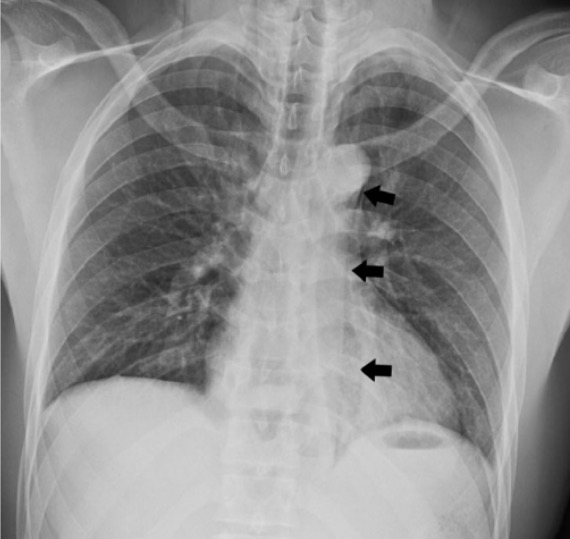Playlist
Show Playlist
Hide Playlist
Esophageal Tears and Perforations
-
Slides GIP Esophageal Tears Perforations.pdf
-
Reference List Pathology.pdf
-
Download Lecture Overview
00:01 Welcome. Let's talk about esophageal tears and perforations, otherwise known as respectively, Mallory-Weiss syndrome or the Boerhaave's Syndrome. 00:11 Epidemiology. So it turns out that both of these tears and perforations are about three times more common in men than women. 00:19 That's because men behave in a way more frequently that will lead to the development of the tears or perforations. 00:27 So you see here in about 40 to 80% of patients who have either one tear or perforation, there is a history of heavy alcohol use. 00:37 Overall, tears or perforations account for somewhere in the neighborhood of about 10 to 15% of upper GI bleeds. 00:48 And what we're looking at on the right-hand side is a beautiful example of a Mallory-Weiss tear at the lower esophageal sphincter, the hole near the top is the sphincter and we have a longitudinal tear in the mucosa that is all the way down into the submucosa where there will be bleeding associated. 01:10 So the pathogenesis of this. It's basically due to rapid increases of intrathoracic or gastric pressures associated with coughing or retching. 01:19 And so violent retching that's associated with heavy alcohol intake and frankly being intoxicated is most commonly as already discussed, the reason for these legions to occur. 01:32 The gastric contents are rapidly evacuated into the lower esophageal segment and with such violent retching or coughing, you have then increased pressures that literally physically rip the mucosa. 01:47 How does this present? So in some cases, it may be totally asymptomatic. 01:53 In most cases, there is some symptomatology. So there will be epigastric or back pain. 02:00 And there's usually acute onset of coughing up or vomiting blood with a history previously of non-bloody vomiting, retching, or coughing. 02:12 The diagnosis is made on the basis of the clinical history, the symptoms and endoscopy. 02:19 And this is showing you a good example at the green arrow of a Mallory-Weiss tear where there's a longitudinal laceration. 02:26 In this case, it's confined to the mucosa and submucosa, will cause bleeding, will cause symptoms as we have gastric contents and gastric acidity bathed over that tear. 02:37 But there is no through and through perforation. 02:41 The Boerhaave's Syndrome is simply the same process but more physical disruption so that we have a transmural perforation from the lumen all the way out into the cirrhosis of the esophagus. 02:55 In Boerhaave's Syndrome, that full thickness tear requires immediate surgery. 03:00 Clearly, you have gastric acidity that is leaking out and we have contents coming from the mouth or a pharynx and the upper esophagus that can leak out and that will result in bacteria and other organisms getting into the mediastinum. 03:16 So if we diagnose a full thickness tear, that requires immediate surgery. 03:23 So the clinical manifestations of Boerhaave's Syndrome, these are really due to getting air into inappropriate areas. 03:31 So not only are you swallowing food but you were also swallowing a degree of air. 03:36 In Boerhaave's, this full thickness perforation. 03:39 You will get subcutaneous emphysema, that is to say air into the skin, soft tissues, and muscle in and around the chest. 03:47 This can actually be physically palpated. We'll feel like crepitus. 03:51 You're kind of punching little air sacs. You can also get pneumomediastinum. 03:55 That is to say air that outlines the mediastinum on a chest x-ray. 04:00 And you can also get dyspnea as you compromise the excursion of the lungs with all the air in the inappropriate places. 04:07 How do we manage this? So with an upper gastroesophageal bleed, acute management of just even a tear, we need to get fluids, and if necessary, transfusions to maintain an adequate hematocrit. 04:20 We need to give therapy to reduce gastric acidity because we don't wanna cause further damage associated with gastric acid in a tear or a frank perforation. 04:32 In most cases for just a tear, the bleeding stops spontaneously. 04:37 But if there is intractable refractory bleeding, we can do a variety of interventions. 04:43 First up would be an endoscopic intervention. We put in a Sengstaken-Blakemore Tube and just inflate it until we get tamponade of the vasculature and it stops bleeding. 04:54 If that doesn't work when we take down the tube and we still get bleeding, then, we have to go to arteriography where we get an interventional radiologist to go into the blood vessels in and around the esophagus. 05:05 And we embolize them so that we don't get blood flow into the area where we're bleeding and the third line. 05:11 And particularly, if there's been a through and through perforation is that we do surgery to oversew the area of injury and perforation. 05:19 And with that, we've covered holes in the esophagus and tears in the esophagus.
About the Lecture
The lecture Esophageal Tears and Perforations by Richard Mitchell, MD, PhD is from the course Disorders of the Esophagus.
Included Quiz Questions
What is the cause of an esophageal tear?
- Sudden increase in intrathoracic or gastric pressure
- Gradual increase in intrathoracic or gastric pressure
- Sudden food impaction in the esophagus
- Gradual food impaction in the esophagus
- Progressive esophageal candidiasis
What symptom is NOT associated with an esophageal tear?
- Constipation
- Epigastric pain
- Hematemesis
- Back pain
- Vomiting
What finding distinguishes Boerhaave syndrome from a Mallory-Weiss tear?
- Transmural perforation
- Hematemesis
- Longitudinal laceration
- Hematochezia
- Flank pain
Customer reviews
5,0 of 5 stars
| 5 Stars |
|
5 |
| 4 Stars |
|
0 |
| 3 Stars |
|
0 |
| 2 Stars |
|
0 |
| 1 Star |
|
0 |




